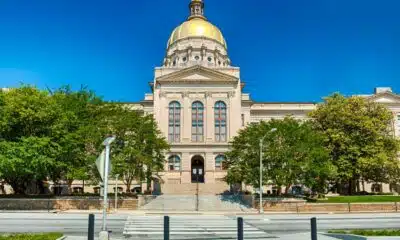News from the South - Texas News Feed
Trump won’t bring back wrongfully deported Maryland man
SUMMARY: The Trump administration is freezing over $2 billion in grants and $60 million in contracts for Harvard University after the school refused to limit campus activism, citing First Amendment rights. Trump officials also stated that despite a Supreme Court order, they cannot bring back Kilar Abrego Garcia, a Maryland man wrongfully deported to El Salvador. President Trump’s meeting with El Salvador’s president confirmed that the decision to return Garcia is not under U.S. control. Additionally, the administration is turning over federal land to the Defense Department for potential military use, despite potential legal challenges. Meanwhile, China’s semiconductors are temporarily exempt from tariffs.
The Trump Administration officials said there’s nothing they can do to bring back a wrongfully deported man from El Salvador. Here’s what we know about the meeting between Trump and El Salvador’s president Nayib Bukele.
Subscribe to FOX 4: https://www.youtube.com/fox4news?sub_confirmation=1
Dallas news, weather, sports and traffic from KDFW FOX 4, serving Dallas-Fort Worth, North Texas and the state of Texas.
Download the FOX LOCAL app: fox4news.com/foxlocal
Watch FOX 4 Live: https://www.fox4news.com/live
Download the FOX 4 News App: https://www.fox4news.com/apps
Download the FOX 4 WAPP: https://www.fox4news.com/apps
Follow FOX 4 on Facebook: https://www.facebook.com/Fox4DFW/
Follow FOX 4 on Twitter: https://twitter.com/FOX4
Follow FOX 4 on Instagram: https://www.instagram.com/fox4news/
Subscribe to the FOX 4 newsletter: https://www.fox4news.com/newsletters
News from the South - Texas News Feed
Officials give update on 5 soldiers shot at Fort Stewart as investigation continues
SUMMARY: Five soldiers were shot at Fort Stewart, Georgia, allegedly by fellow servicemember Sgt. Quornelius Radford, 28, using a personal handgun. The attack occurred Wednesday morning at the 2nd Armored Brigade Combat Team complex. Six soldiers tackled Radford, disarmed him, and gave lifesaving aid to the wounded, actions praised by Army Secretary Dan Driscoll. Three victims were released from Winn Army Community Hospital; two remain hospitalized, one in Savannah. Officials have not disclosed a motive and note personal firearms are banned on base. The Army is investigating how Radford brought the weapon on site, with safety concerns again raised for military installations.
The post Officials give update on 5 soldiers shot at Fort Stewart as investigation continues appeared first on www.kxan.com
News from the South - Texas News Feed
I Came from Rural Texas to Harvard’s MD-PhD program. Now, Trump Defunded that Program.
Even lifelong Texans may not have heard of my hometown of Lindale. With just under 5,000 people while I lived there, Lindale sits roughly 90 miles east of Dallas and bears many hallmarks of a small Texas town: more than three churches per square mile, roads dominated by trucks, and packed football stadiums on Friday nights. It’s also overwhelmingly white. On paper, Lindale might seem an unlikely home for an Indian-American kid. In reality, it was great to me.
Whether playing basketball nearby or attending a debate tournament out of town, my friends’ parents looked after me like I was their own—including by scolding me when needed. Teachers occasionally drove me home after late practice for a math or band competition—teachers who were as impressive as they were kind. My debate coach could easily help me with a speech or Algebra II homework; my calculus teacher excelled at explaining differential equations and coaching soccer.
My path to medicine began in Lindale, too. I went to college at the University of Texas at Austin (hook ’em), but my interest in becoming a doctor developed through working with clinicians at Lindale Medical Clinic and hospitals in nearby Tyler. I never dreamed these experiences would take me to Harvard Medical School. But my teachers did. After I competed in a debate tournament at Harvard University, one joked, “You could end up in school there; just be a smart, well-rounded, hard-working liberal.” The joke did not surprise me—Lindale sits in Smith County, a deep-red county in East Texas where more than 70 percent of voters backed Donald Trump in the last election. Politics aside, the people of Lindale saw Harvard as an incredible place to learn. They were right. Their belief helped propel me to the Harvard/MIT MD-PhD Program.

This rigorous program bridges clinical medicine and research. Students complete the first two years of medical school, earn a PhD, then finish the final two years of medical school. Most often, graduates continue to hospital residency and careers at academic medical centers, where they care for patients while pursuing new cures, treatments, and diagnostic tools. In the process, they improve the health of individual patients and the future of medicine itself.
To enable this mission, the National Institutes of Health (NIH) funds 57 MD-PhD programs through its Medical Scientist Training Program. These grants, which totaled $4 million for the current academic year, come with strict requirements to ensure that spending aligns with the NIH’s ultimate goal of improving human health through science.
On May 15, 2025, both NIH grants that support the Harvard/MIT MD-PhD Program were terminated as part of a broader attempt by the federal government to terminate direct NIH funding to Harvard Medical School. Thirty-two students who spent countless hours applying for and earning NIH F30 fellowships saw their awards vanish. These decisions affect not just the archetypal Harvard student many imagine—they affect people who grew up in Lindale, people whose parents are not doctors or scientists, people who attended public schools their entire lives, people who tirelessly pursued a career in service of others, and people who often decline lucrative private practice and dedicate their lives to life-saving research.
My classmates are among the hardest-working people I know. Publishing a peer-reviewed biomedical research paper routinely demands years of perseverance and troubleshooting. In 2024 alone, the Harvard/MIT MD-PhD Program’s 208 students co-authored more than 180 peer-reviewed publications. Those students regularly work more than 12 hours a day conducting and repeating experiments in laboratories followed by continued reading, writing, and coding at home. Instead of halting this work, the government should support it—it’s an investment in our collective health as a country.
Consider Dr. Arlene Sharpe and Dr. Vijay Sankaran. Sharpe, who obtained her MD and PhD from Harvard Medical School, made discoveries critical to the development of cancer immunotherapy drugs that have redefined cancer treatment. Sankaran, while still a student in the program, contributed to a discovery that led to the first FDA-approved CRISPR/Cas9 gene therapy for sickle cell disease. Such life-changing research takes time. More than a decade passed between each discovery and drug approval. And not every story ends in success. Research can fail, scientists’ hypotheses can turn out to be wrong, and a discovery’s long-term importance may not immediately be clear. Yet, losing patience or faith in the research process risks failing to provide improved treatments for patients everywhere.
Whether a biomarker can improve the diagnosis of pancreatic cancer, a genetic mutation affects a person’s risk of Alzheimer’s disease, or a molecule kills an antibiotic-resistant superbug is not political. My classmates and I are working on each of these problems and countless others.
Our mentors apply for and win government grants that fund this research for the benefit of all Americans. Terminating those grants threatens our ability to do this research and, with it, the promise of making discoveries that will one day improve and save lives.
The post I Came from Rural Texas to Harvard’s MD-PhD program. Now, Trump Defunded that Program. appeared first on www.texasobserver.org
Note: The following A.I. based commentary is not part of the original article, reproduced above, but is offered in the hopes that it will promote greater media literacy and critical thinking, by making any potential bias more visible to the reader –Staff Editor.
Political Bias Rating: Center-Left
This content leans center-left due to its focus on the value of scientific research funded by government institutions like the NIH and its critique of recent federal government actions that negatively impact such funding. It highlights the contributions of researchers and the importance of sustained public investment in biomedical science, which aligns with a perspective that favors strong government support for education and research. The article avoids partisan rhetoric, acknowledges conservative-leaning local contexts (like Lindale, Texas), and frames the issue primarily around evidence-based policy and public good rather than ideological confrontation, situating it in a moderate progressive stance.
News from the South - Texas News Feed
Abbott appointed justices who will weigh House expulsion bid
“Abbott’s bid to expel the House Democratic leader goes to a court filled with his appointees” was first published by The Texas Tribune, a nonprofit, nonpartisan media organization that informs Texans — and engages with them — about public policy, politics, government and statewide issues.
Sign up for The Brief, The Texas Tribune’s daily newsletter that keeps readers up to speed on the most essential Texas news.
Texas Democrats had been out of state for less than 48 hours when Gov. Greg Abbott moved to have their seats declared vacant.
The emergency legal filing represents an unprecedented escalation of Abbott’s effort to pass a new congressional map that adds additional GOP seats, as demanded by President Donald Trump. It flies in the face of Texas’ own founding documents, centuries of legal precedent and a recent Supreme Court of Texas ruling, legal experts say.
Even Attorney General Ken Paxton, a fellow Republican, threw cold water on Abbott’s strategy, filing his own brief saying that while he “appreciates the Governor’s passion,” he does not have the authority to bring this type of case.
But just because legal precedent is not on his side doesn’t mean Abbott’s case is doomed. The long-shot filing is before the all-Republican Texas Supreme Court, where Abbott has appointed six of nine justices. Chief Justice Jimmy Blacklock was Abbott’s former general counsel, as was Justice James Sullivan.
“They have their own independent authority, of course, but it does put them in a tough political position,” said Andrew Cates, an Austin-based attorney and expert on Texas ethics law. “They don’t want to be in the position of potentially biting the hand that initially fed them.”
Abbott’s petition specifically targets Rep. Gene Wu, the House Democratic leader, serving as a test case that could eventually allow him to remove every member who left the state. Abbott asked the court to rule by Thursday; the justices gave Wu until the end of the day Friday to respond.
It is hard to argue that leaving the state to deny the Legislature a quorum is equivalent to abandoning an office, legal experts say. Texas’ constitution sets an intentionally high threshold for quorum — two-thirds of the chamber, compared to half in most other states — in an effort to limit the majority’s complete authority. And centuries of quorum breaks, both in Texas and other states, have resulted in expulsion only once, during the colonial era, when members of the New Jersey assembly, upon regaining quorum, voted to remove their peers who stayed away.
“The law allows for consequences, like arrests and fines, to entice the members back,” said Charles “Rocky” Rhodes, a constitutional law expert at the University of Missouri law school. “If they wanted to say you lose your office, they could have put that in there, but they didn’t.”
Dereliction or duty?
Dozens of Democrats left the state Sunday afternoon, heading for Illinois, New York and Massachusetts, announcing their intent to deny the House the quorum it needs to pass legislation. A total of 57 Democrats were absent when the House gaveled in the next day, leaving the chamber shy of the 100-member threshold.
“We’re not walking out on our responsibilities; we’re walking out on a rigged system that refuses to listen to the people we represent,” Wu said in a statement as the Democrats prepared to depart. “As of today, this corrupt special session is over.”
There have been just 15 legislative walkouts nationwide since 1924, almost all in the four states that require the presence of two-thirds of legislators to conduct business, according to Ballotpedia.
Texas is one of these high-threshold states. A two-thirds quorum has been required by the Texas Constitution since 1845, an uncontroversial proposal for a people who have “long been suspicious of their government and desirous of limiting its powers,” said Texas constitutional historian Bill Chriss.
The framers of the Texas Constitution imagined that there might come a day when members declined to attend in protest, writing that legislators were empowered to “compel the attendance of absent members, in such manner and under such penalties as each House may provide.”
Democrats most recently decamped in 2021 to stop a GOP voting bill, nearly two decades after fleeing to block a similar mid-decade redistricting effort. In both cases, Republicans issued arrest warrants and sent state troopers to look for the missing lawmakers, although since they had left the state, these measures had little effect.
In 2021, when Democrats sued to challenge the arrest warrants, Blacklock authored an opinion affirming that the Texas Constitution explicitly “enables ‘quorum-breaking’ by a minority faction of the Legislature.”
The constitution also allows “quorum-forcing,” Blacklock said, adding that each chamber could decide for itself how to entice members back to work. The next session, the House voted to add a $500-a-day fine for unexcused absences.
Nowhere in that argument does it say that a quorum break constitutes the abandonment of office needed to remove them from their post, Rhodes said. But that’s exactly what the governor argued in his petition.
“Longstanding precedent recognizes that deliberate abandonment of office constitutes a forfeiture of that office,” Abbott wrote in the filing. “Indefinite removal to another state for purposes of avoiding the constitutional requirement that [legislators] ‘shall meet’ likewise vacates the office.”
For a legislator to have abandoned their office, they must have failed to perform their duties and expressed their intent to abandon the position. In the filing, Abbott said the court can infer from Wu’s conduct that he intended to relinquish his office.
“Wu has expressed his intention to abandon the office three times over — with no end in sight — by openly acknowledging his abandonment of his official duties, accepting compensation and other benefits to abandon those duties, and fleeing the sovereign territory he purports to represent,” Abbott wrote.
Jim Dunnam, a Waco attorney and former state lawmaker, said that was an outlandish interpretation of the law. Dunnam led the Democrats on their 2003 quorum break; Republicans called them chickens and sent the state troopers after them, but there was never any talk about declaring their seats vacant, he said.
“If the Supreme Court is going to follow the law, there’s no problem here, because these people have not abandoned their office,” Dunnam said. “They’re doing exactly what they were elected to do.”
Abbott, a former Texas Supreme Court justice and attorney general, should know that this argument stretches the law beyond the breaking point, Dunnam said.
“I would say this whole thing is a joke, but for the pressure we’ve seen that Trump has been able to exercise across the nation, and certainly among Texas Republicans,” he said.
On whose authority?
As the head of the executive branch, Abbott’s ability to remove a duly elected state representative is limited by the state Constitution’s separation of powers clause.
So he’s trying a unique legal mechanism, called a quo warranto petition, that allows state officials to try to oust an officeholder who has abandoned their office.
State law says this type of action must be filed in district court by the attorney general or a county or district attorney. Paxton alluded to this as a potential roadblock to removing quorum-breakers, telling conservative podcaster Benny Johnson that they’d have to file individual lawsuits in each member’s district, many of which are in counties where Democrats dominate the bench.
“We’d have to go through a court process, and we’d have to file that maybe in districts that are not friendly to Republicans,” Paxton said. “So it’s a challenge because every district would be different.”
Abbott’s petition seeks to sidestep all of that and go directly to the Texas Supreme Court. In a recent unrelated ruling, the high court said it had reviewed direct quo warranto petitions “on only a few occasions, always denying the writ when we have done so.”
Paxton weighed in Tuesday, sending a letter to the court saying only his office or a local prosecutor can bring this type of legal action. He has vowed to do so if the Democrats do not return to the chamber by Friday.
Abbott countered, saying he was bringing his petition under a different authority than Paxton’s and asking the court to rule before Friday. The justices have not yet weighed in on the petition or the infighting.
The nuances of the quo warranto petition may provide the justices with a procedural off-ramp, allowing them to dismiss the challenge on these technical grounds without getting into the more politically charged merits of the case, Cates said.
“But I don’t think we’ve ever had such exigent circumstances where the governor is the one that is asking, and there’s a ticking clock, a special session, congressional maps and all that,” he said. “So there’s maybe a first time for everything.”
If the Texas Supreme Court were to find that these members have abandoned their offices, Abbott would have to call a special election to fill the seats. They are likely to be replaced by similarly aligned candidates, considering the political makeup of those districts, which Abbott knows, Cates said.
“I think this is going to be a long, drawn-out court fight, and I think every side knows it,” Cates said. My guess is that this is more about a scare tactic to try and win a war of attrition to bring back scared members that were on the fence, and try to trickle their way into quorum.”
The lineup for The Texas Tribune Festival continues to grow! Be there when all-star leaders, innovators and newsmakers take the stage in downtown Austin, Nov. 13–15. The newest additions include comedian, actor and writer John Mulaney; Dallas mayor Eric Johnson; U.S. Sen. Amy Klobuchar, D-Minnesota; New York Media Editor-at-Large Kara Swisher; and U.S. Rep. Veronica Escobar, D-El Paso. Get your tickets today!
TribFest 2025 is presented by JPMorganChase.
This article originally appeared in The Texas Tribune at https://www.texastribune.org/2025/08/07/greg-abbott-texas-democrats-quorum-break-supreme-court-removal/.
The Texas Tribune is a member-supported, nonpartisan newsroom informing and engaging Texans on state politics and policy. Learn more at texastribune.org.
The post Abbott appointed justices who will weigh House expulsion bid appeared first on feeds.texastribune.org
Note: The following A.I. based commentary is not part of the original article, reproduced above, but is offered in the hopes that it will promote greater media literacy and critical thinking, by making any potential bias more visible to the reader –Staff Editor.
Political Bias Rating: Center-Left
The article presents a critical perspective on Governor Greg Abbott’s legal efforts to remove Democratic legislators who fled the state to break quorum. It emphasizes legal experts’ views that Abbott’s petition stretches constitutional interpretations and highlights internal Republican disagreements, including skepticism from Attorney General Ken Paxton. The tone frames the Democrats’ actions as a response to a “rigged system” while portraying Abbott’s moves as politically motivated and aligned with GOP interests, particularly those of former President Trump. Overall, the piece leans toward a center-left viewpoint by scrutinizing Republican actions more than Democratic ones, though it includes multiple viewpoints and factual context.
-
News from the South - Texas News Feed7 days ago
Rural Texas uses THC for health and economy
-
Mississippi Today3 days ago
After 30 years in prison, Mississippi woman dies from cancer she says was preventable
-
News from the South - Georgia News Feed5 days ago
Woman charged after boy in state’s custody dies in hot car
-
Our Mississippi Home6 days ago
Porch Lights and Lightning Bugs: An August Evening in Mississippi
-
News from the South - Georgia News Feed7 days ago
Trump's new tariffs give some countries a break, shares and US dollar sink
-
Mississippi News Video7 days ago
Safe Haven Baby Box opens in Gluckstadt
-
News from the South - Oklahoma News Feed7 days ago
Woman honored for 50 years of giving back
-
News from the South - Georgia News Feed7 days ago
Georgia’s youngest children deserve continuous Medicaid coverage














































